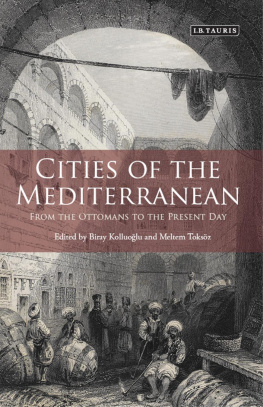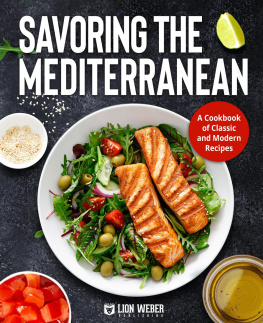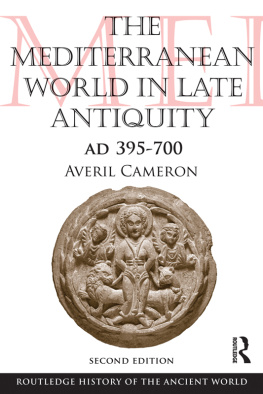Meltem Toksoz - Cities of the Mediterranean
Here you can read online Meltem Toksoz - Cities of the Mediterranean full text of the book (entire story) in english for free. Download pdf and epub, get meaning, cover and reviews about this ebook. year: 2019, publisher: Bloomsbury Publishing, genre: Romance novel. Description of the work, (preface) as well as reviews are available. Best literature library LitArk.com created for fans of good reading and offers a wide selection of genres:
Romance novel
Science fiction
Adventure
Detective
Science
History
Home and family
Prose
Art
Politics
Computer
Non-fiction
Religion
Business
Children
Humor
Choose a favorite category and find really read worthwhile books. Enjoy immersion in the world of imagination, feel the emotions of the characters or learn something new for yourself, make an fascinating discovery.
- Book:Cities of the Mediterranean
- Author:
- Publisher:Bloomsbury Publishing
- Genre:
- Year:2019
- Rating:5 / 5
- Favourites:Add to favourites
- Your mark:
- 100
- 1
- 2
- 3
- 4
- 5
Cities of the Mediterranean: summary, description and annotation
We offer to read an annotation, description, summary or preface (depends on what the author of the book "Cities of the Mediterranean" wrote himself). If you haven't found the necessary information about the book — write in the comments, we will try to find it.
Cities of the Mediterranean — read online for free the complete book (whole text) full work
Below is the text of the book, divided by pages. System saving the place of the last page read, allows you to conveniently read the book "Cities of the Mediterranean" online for free, without having to search again every time where you left off. Put a bookmark, and you can go to the page where you finished reading at any time.
Font size:
Interval:
Bookmark:

Biray Kolluolu is Associate Professor of Sociology at Boazii University, Istanbul. She has published on late nineteenth-century and early twentieh-century Izmir. Her research interests include historical sociology, nationalism, sociology of space and memory.
Meltem Toksz, Associate Professor of History at Boazii University, Istanbul. She has published on the Eastern Mediterranean cotton agriculture and trade, Ottoman Mersin and the regional history of Cilicia. Her research interests include historiography, Ottoman intellectual history and the modernisation of state and society in late Ottoman history.

New paperback edition first published in 2014 by I.B.Tauris & Co. Ltd
6 Salem Road, London W2 4BU
175 Fifth Avenue, New York NY 10010
www.ibtauris.com
Distributed in the United States and Canada
Exclusively by Palgrave Macmillan
175 Fifth Avenue, New York NY 10010
First published in hardback in 2010 by I.B.Tauris & Co. Ltd
Copyright 2010, 2014 Biray Kolluolu and Meltem Toksz
The right of Biray Kolluolu and Meltem Toksz to be identified as the editors of this work has been asserted by them in accordance with the Copyright, Designs and Patents Act 1988.
Copyright Editorial Selection 2010, 2014 Biray Kolluolu and Meltem Toksz
Copyright Individual Chapters 2010, 2014 Isa Blumi, Edmund Burke III, Johann Bssow, Erkan Grpnar, Vilma Hastaoglou-Martinidis, Constantin Iordachi, Vangelis Kechriotis, alar Keyder, Carla Keyvanian, Biray Kolluolu, Eyp zveren, Cristina Pallini, Faruk Tabak, Meltem Toksz.
Every attempt has been made to gain permission for the use of the images in this book. Any omissions will be rectified in future editions.
All rights reserved. Except for brief quotations in a review, this book, or any part thereof, may not be reproduced, stored in or introduced into a retrieval system, or transmitted, in any form or by any means, electronic, mechanical, photocopying, recording or otherwise, without the prior written permission of the publisher.
References to websites (URLs) were accurate at the time of writing.
ISBN: 978 1 78076 769 7
eISBN: 978 0 85773 745 8
A full CIP record for this book is available from the British Library
A full CIP record is available from the Library of Congress
Library of Congress catalog card: available
To the memory of Faruk Tabak
Contents
Biray Kolluolu and Meltem Toksz
alar Keyder
Faruk Tabak
Carla Keyvanian
Cristina Pallini
Vilma Hastaoglou-Martinidis
Johann Bssow
Isa Blumi
Vangelis Kechriotis
Constantin Iordachi
Eyp zveren and Erkan Grpnar
Edmund Burke III
List of Illustrations
Battista Agnese, Portolan Chart of the West Mediterranean ca. 1544, Library of Congress
Antonio Lafreri, Melita Insula (Island of Malta), 1551, Biblioteca Apostolica Vaticana, St.Geogr.I.73.
Anonymous, Malta, 1565(?), Biblioteca Apostolica Vaticana, Barb.P.IX.47.
Antonio Lafreri, Giovanni Orlandi, Harbor of Malta (detail), 1565/1602, Gabinetto Nazionale delle Stampe, Rome.
Agostino Musi, Tunisia (detail), 1535, Private Collection
Antonio Salamanca, Algeri, 1541, Private Collection
Claudio Duchetti, Giovanni Orlandi, Fortezza di Gerbi (Fortress of Jerba), early 1550s/1602, Biblioteca Apostolica Vaticana, St.Barb.X.I.80, Pl.20.
Anonymous, Jerba, 1560(?), Gabinetto Nazionale delle Stampe, Rome.
Anonymous, Tripoli, 1560(?), Gabinetto Nazionale delle Stampe, Rome
Mapping Out the Eastern Mediterranean: Toward a Cartography of Cities of Commerce
Biray Kolluolu and Meltem Toksz
Our mental mapping of the globe through continents rests on an imagery of large bodies of water constituting limits, boundaries and obstacles to the free flow of peoples, goods, information and knowledge while land masses connote integration and belonging. Perhaps the Mediterranean stands out as the only body of water representing historical connectedness and unity. Here the sea, at least until the nineteenth century, overshadowed the lands around it, thus rendering possible the question is it the sea surrounded The Mediterranean seems to have lost this eminency in the last century. The unprecedented dynamism and dizzying speed of the modern world has so destroyed all former worlds, turning them into fading memories, that today our hegemonic geographic discourse is shaped by wests, middles, and easts of a continent. That is perhaps why the Mediterranean, after it surfaced from the whirlpool of capitalist social change, has mostly glittered on its northern and western shores. Indeed, when it is the dazzle of change that shapes our imaginary, it is not surprising that historical continuity is discarded as dreary. The centuries-old continuity of the Mediterranean, especially the role of its eastern shores, is buried under layers of rapturous social change.
This book is about the cities of commerce of the southern and eastern shores of the Mediterranean that have been the spaces of links, networks, and riches, also awash by conflicts, wars, and boundary contestations. These cities have occupied a central geo-political, commercial, and cultural place in the ever-expanding and ever-intensifying circuits of global exchange since the sixteenth century. We began to imagine this book in early 2004 in a city in the north, namely in Berlin at the Wissenschaftskolleg. We were invited to this Institute of Advanced Study as part of a working group on New Approaches to the History of Merchant Cities in the Ottoman Empire and Its Successor States. Our working group was only one among many if one considers the large number of conferences and workshops, post-graduate research programs, and dissertations, articles and books on the Mediterranean cities of commerce of the nineteenth century, testifying to an explosion of interest in these spaces since the closing decade of the twentieth century.
Ottoman port-cities made their debut on the scholarly scene more than a decade ago via the world-system This group of scholars had set out with a specific agenda. They were not interested in port-cities per se but focused on the processes of peripheralization, not only of the Ottoman Empire, but also of India, and China. Eastern Mediterranean ports forced themselves onto their desks within the framework of the questions they asked as apparent nodes of commodity exchanges and other forms of capitalist encounters. In their research agenda, port-cities came to be treated as suitable means for the confirmation and further proliferation of the world-system analysis.
Today, the locales that this line of inquiry is taken up are multiple and varied. The above-mentioned conferences, workshops, post-graduate research programs, dissertations and books that are attempting to understand the dynamism of cities of commerce in history constitute a disconcerted effort. While the world-system perspective diffused an overly structured analysis, contemporary research is dispersed. The latter is being carried out not around a common perspective, but rather around a shared set of concerns meshed with those of urban history. Both the world-system perspective and the contemporary research have their pitfalls. The world-system perspective in its first attempt ended up drawing a picture in which the colors of the world-economy were exaggerated and colors of the local remained faint and shady. The shortcoming of the current research is its severely disparate character. While it is always incredibly important to gather detailed
Font size:
Interval:
Bookmark:
Similar books «Cities of the Mediterranean»
Look at similar books to Cities of the Mediterranean. We have selected literature similar in name and meaning in the hope of providing readers with more options to find new, interesting, not yet read works.
Discussion, reviews of the book Cities of the Mediterranean and just readers' own opinions. Leave your comments, write what you think about the work, its meaning or the main characters. Specify what exactly you liked and what you didn't like, and why you think so.









